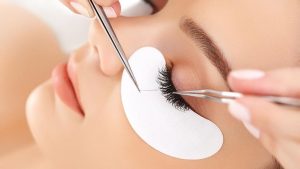 False eyelashes have been part of many a woman’s beauty kit for decades, but the new craze is for semi-permanent eyelash extensions.
False eyelashes have been part of many a woman’s beauty kit for decades, but the new craze is for semi-permanent eyelash extensions.
Unlike regular false eyelashes, where you have synthetic lashes applied to your eyelid and then (easily) removed afterwards, eyelash extensions are applied individually, directly to the natural eyelash with a bonding agent, and can last (with care) for up to six weeks. This means you can leap out of bed looking like a celebrity without touching a mascara wand, but the downside could be an eye infection or worse if the person applying the lashes hasn’t had adequate training or isn’t using the right equipment.
Dr Tasha Micheli, Ophthalmologist and Chair of the NSW College of Ophthalmologists, says eye doctors are seeing a small but increasing parade of patients who have suffered injuries as a result of eyelash extensions.
She says the main problem is with foreign bodies getting into the eye and causing corneal ulcers, which can lead to vision loss.
“Shards from the eyelash fibres scratch the cornea and leave the fine fibres which are mink or silk; they can damage something embedded within the lid. You really won’t be able to see them yourself but it doesn’t mean they aren’t there.”
Melbourne-based optometrist Samantha Day says she doesn’t recommend eyelash extensions at all when her patients ask about them. “Even for people who have never had an eye problem before, using lash extensions may cause an eye disorder and this can occur in up to one in four people who use them. Most problems will resolve with treatment and without causing permanent vision loss, however, there may be a permanent loss of natural lashes.”
Serious risks of eyelash extensions
Keratoconjunctivitis: an infection or inflammation of the cornea and conjunctiva, a result of glue or removing agent leaking into the eye during the application and removal process.
Allergic blepharitis: inflammation of the lids, as a result of an allergic reaction to the glue, particularly to the formaldehyde in the glue, or an allergy to the eyelid fixing tape used during the procedure.
Conjunctival erosion: from the eyelid fixing tape and a risk of sub-conjunctival haemorrhage (bleeding under the conjunctiva) from compression on the eye during lash extension removal.
Traction alopecia: where the natural lashes fall out as a result of the constant weight of repeated eyelash extension treatments. In some cases the lashes may not regrow at all.
An eyelash extension treatment gone wrong can put your eyes in serious peril. Despite this, there are currently no training requirements in Australia, so in theory anyone can set up a business or sideline in applying lash extensions.
According to Andrea Day of Victoria University, “in order to do business, those providing the service need to adhere to local, state or territory, and federal Work Health and Safety (WHS) guidelines and legislation, however training is not a legal requirement”. The beauty industry often has to keep up with new techniques and products, and with consultation underway, is pushing to have a nationally recognised qualification for eyelash technicians next year.
In the meantime, if the lure of long lashes still has you keen to give the treatment a try, Day recommends seeking out an eyelash technician who holds a nationally recognised make-up qualification, including the WHS skills needed to apply temporary false lashes. Certificate II in Retail, Make-up and Skin Care, Certificate III in Beauty Services, Certificate IV or Diploma in Beauty Therapy-qualified eyelash technicians have been at the very least trained and assessed according to fixed criteria in ‘applying standard infection control precautions’ and ‘recognising and managing contraindications and adverse effects’ when applying temporary false eyelashes.
In a nutshell, the higher the level of qualification, the more a person is skilled in infection control, including hand-washing techniques, disinfecting the tweezers, and preparation of the work area.
What else to look for
BEFORE:
Look for a practitioner or salon that is well established and is dedicated solely to providing lash extensions as their primary business.
Ask to see the products being used. Read the label of the product to check for any chemicals being used that you may be allergic to. The adhesive used should be ‘pharmaceutical grade’ and be safe for use on the eye area.
The lashes themselves are usually advertised as synthetic, silk or mink. A softer, lighter lash such as mink will put less tension on the hair follicle.
Make sure they use a fan to keep fumes away from your eyes at the workstation and that they ‘cure’ each lash with either a mist of isopropyl alcohol at the end of the application or by rinsing the eyes straight afterward so no adhesive residue remains on the lashes.
Consider having an allergy test done first. While allergies aren’t that common, it’s better to be safe than sorry.
AFTER:
Follow the aftercare advice given by the practitioner: if you want to go swimming or use mascara on your extensions, check with the practitioner first as this can vary depending on the kind of procedure you have had done.
See a health professional if you experience any discomfort or irritation. A problem with your eye can quickly go from bad to worse, so don’t wait. An Optometrist is your first point of call and they can refer to a specialist if required.
THINK TWICE ABOUT GETTING EYELASH EXTENSIONS IF YOU:
-already have sparse lashes
-cannot afford the time or money for regular maintenance
-have known allergies to an ingredient in the adhesive or are allergy-prone
-are pregnant.
Data source: Choice








